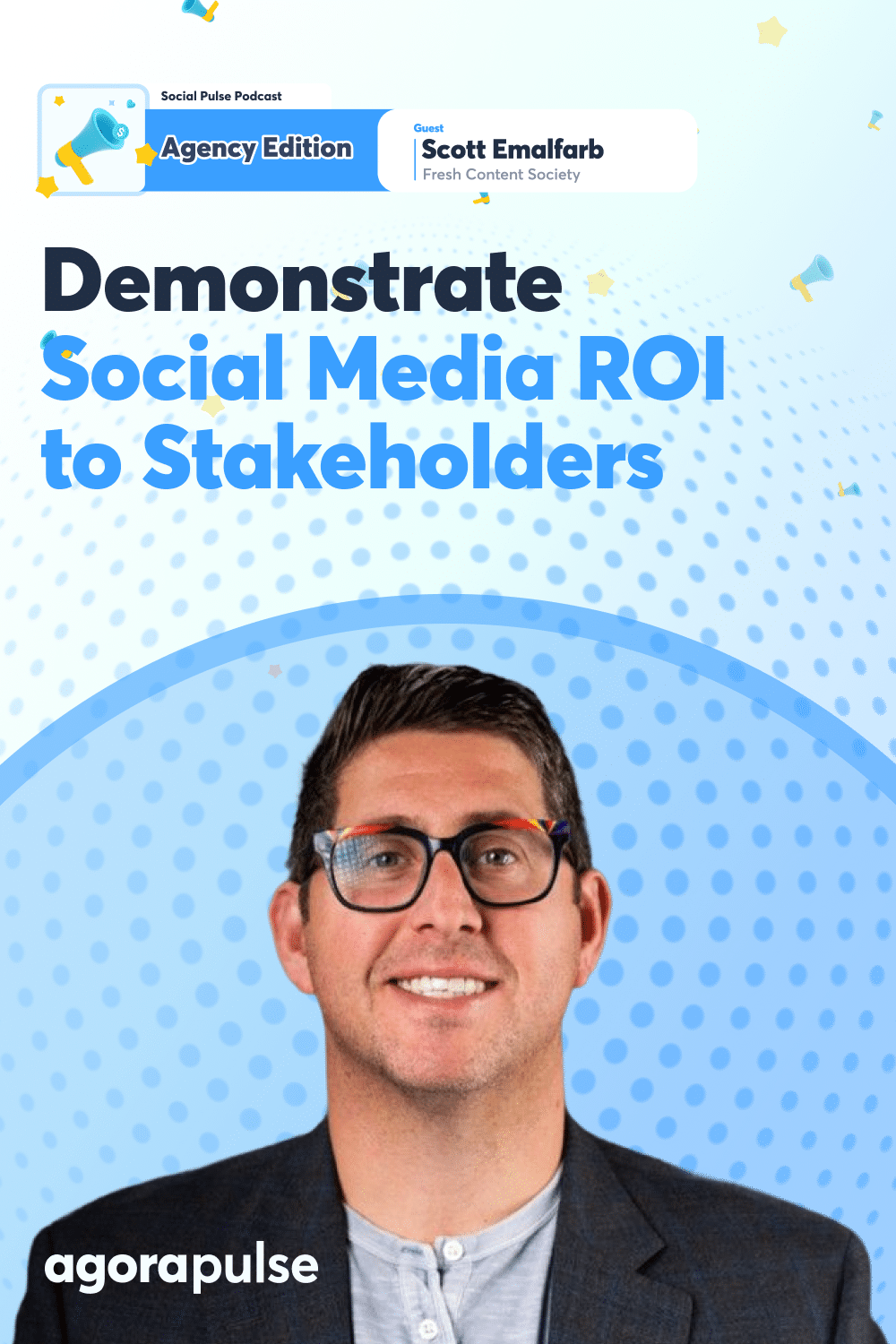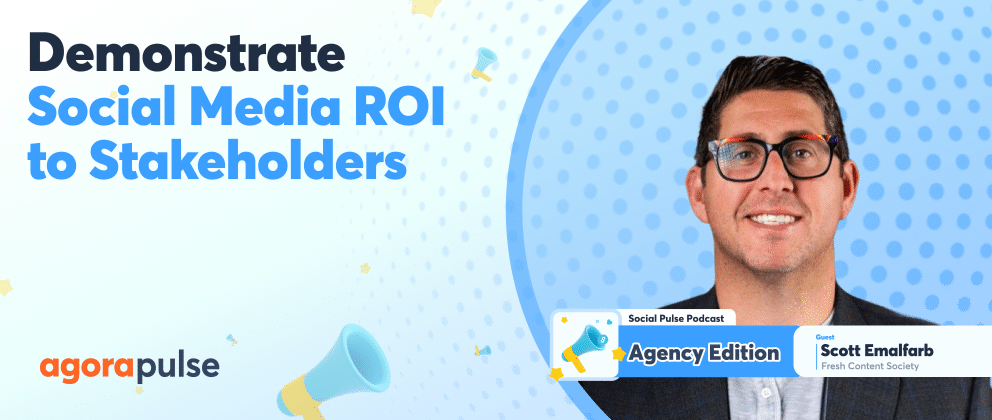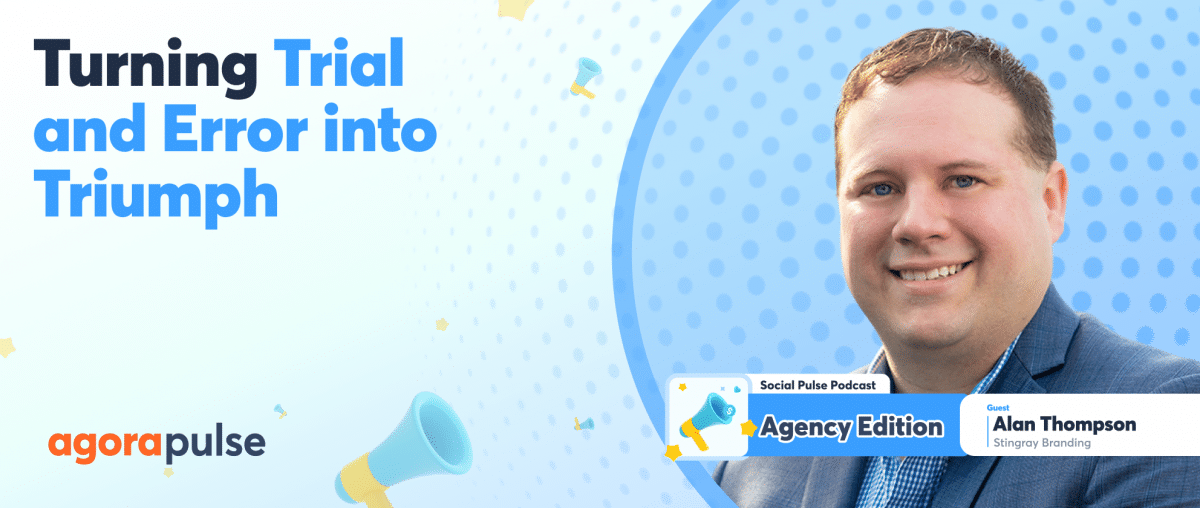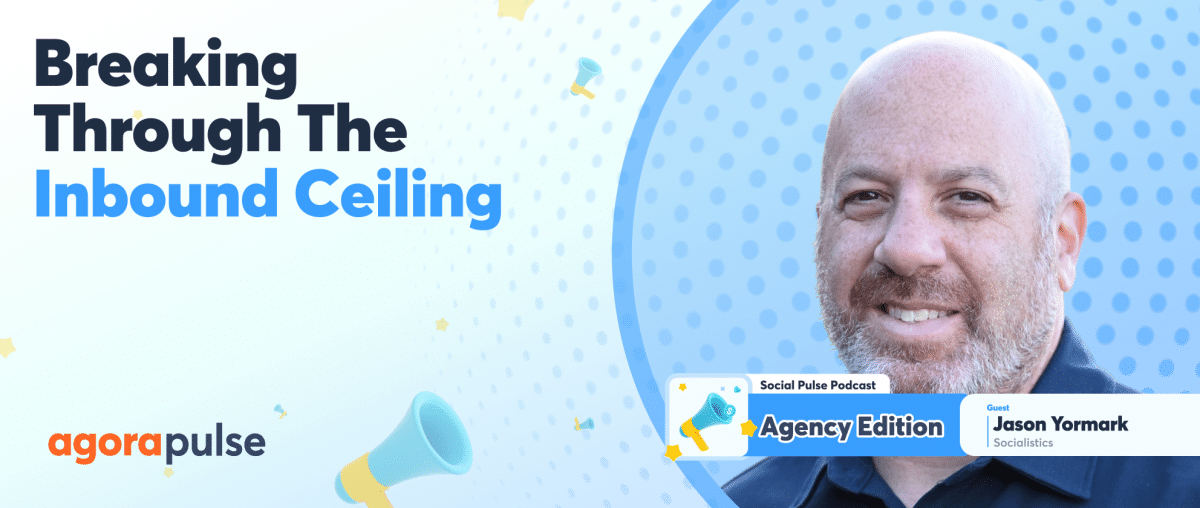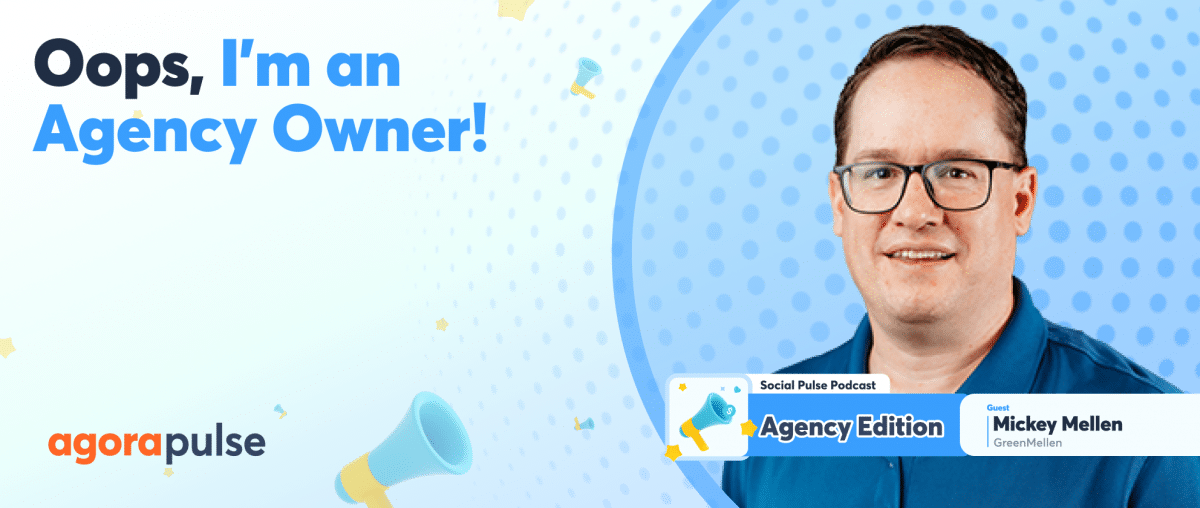Trying to explain engagement rates to someone who just wants to know about sales is like trying to pay rent with Monopoly money: The value’s clear to you, but they’re just not buying it.
Today’s Social Pulse: Agency Edition, powered by Agorapulse, guest Scott Emalfarb is the founder and CEO of Fresh Content Society, social media whisperer, and ROI translator extraordinaire. He’s here to cut through that confusion. This is the guy who turned a desperate tweet from a struggling deli into a 1500% sales increase during the pandemic. Scott has cracked the code on speaking the language of social media value to everyone from skeptical CEOs to hungry CMOs to overwhelmed social media managers.
[Listen to the full episode below, or get the highlights of the Social Pulse: Agency Edition, powered by Agorapulse. Try it for free today.]
Tell us about facing significant pushback from a client about social media, ROI, and how that experience shaped your approach to communicating value
Scott Emalfarb: This dates back as far as I can remember: When businesses were allowed to promote themselves through social media, starting with a Facebook page. Back in the day, we have to remember—and I’m talking close to 2007, six time frames—posting on Facebook on behalf of your business was considered free. It was a free promotion. You were able to post for free, and I think that baseline and that foundation set a bad precedent for how social media marketing started and what the value of social media marketing offered businesses.
So, fast forward, right over the years, working with many different clients, many different businesses ranging from Fortune 500 companies to the great case study example that you shared—Mike with Manny’s Deli and ROI as it relates to social media is very confusing across the board at all levels within an organization, whether you’re the owner of Manny’s Deli or if you are the CEO of a Fortune 500 company.
Now, what I have found most interesting, and I’m going to get to the actual case study or example, but now we have realized that social media does have an ROI. And so every client that I talk to, or I have worked with, or FCS has worked with. We’re very clear on communicating what ROI is, even available, and for us to be able to identify what that ROI is based on what the client’s needs are, allows us to be very clear on what we can control, right?
One great example of that would be if we want to use Manny’s Deli as an example. After many years, I would say we’ve been working with Manny’s Deli since 2015.
In 2020, when the pandemic hit, we spent five years working on a strategy to build community, more followers, more people to engage with us, more people to see our post, getting other people to see our post, other influencers to come in, and when the pandemic hit. We were able to leverage our community to monetize by asking for help because we were struggling.
I say “we” as a business, but the owner at Manny’s Deli was dealing with some significant business issues and challenges in terms of revenue. And by cultivating a community, we were able to ask for help, ultimately, and people showed up, and they showed up in droves. And we had lines wrapped around the block within, I would say, two hours of when the tweet dropped or when the post dropped on social media.
So from there in 2020, I realized, oh, one post can change everything, but the only way you can monetize is not the only way.
One of the ways that you can monetize is by having an actual community that wants to support you.
Mike Allton: That makes a lot of sense.
In one of our other shows, Hospitality Edition, I talked to Potter’s Resorts who similarly during the pandemic, which is a seaside resort on the southeast side of England, and obviously, they had to shut down in March 2020. They had to literally send people home. They had to call people who had reservations for the next few days or weeks and say, “Sorry, we have to close down. You can’t come in.” Because they built such a terrific community like Manny’s, 80% of their customers said, “Keep our money!”
Check out the episode with Potters Resort about turning crisis into opportunity!
Can you break down key differences in what a business owner versus an A CMO versus another social media manager and how they each want to hear about ROI differently?
Scott Emalfarb: Absolutely. Okay, so let’s start from the top level. When we think about ROI, the two buckets of ROI that we can accomplish on social media are making money and building community. Those are the two buckets: “Make Money” and “Build a Community,” and both could work together. Now, for us to either make money or build community, there are two ways to achieve that.
Paid ads or organic social, which is earning its organic social right, helps focus on this journey, which is much longer to the “Make Money” bucket. But it’s the journey of earning and building a community that you can monetize. But that journey is much longer to get to Manny’s Deli and Potter’s. Same ideas. I guarantee it didn’t happen overnight from them building that community. Yeah, but you can leverage paid media as well to help make money quicker on social through Meta ads or TikTok ads, or YouTube ads, and they all work together.
So if I’m talking to a CEO, the CEO lives in this bucket of making money. Yeah, they’re in the business of that. Now I have to do a decent job to get to this bucket. Now, for us to get to this bucket on the organic side, which is what we specialize in, we have to take the earned approach, which is we have to work on building a community to get to this horizon. So, for us to get to this horizon, we have to build a community.
And when we build community, there are social media KPIs that help us identify that we’re on track to building a community of supporters, of people that want to buy from us, support us, engage with us, and be part of our journey. Now, if I’m talking to a director of digital marketing or director of social marketing, this bucket of “Make Money” is obviously and always the most important at any business.
But as the director of social or digital, and or both, they’re spending time in the brand bucket in my Brand Awareness bucket and for us to get more brand awareness. They care about the community-building metrics. So, more followers are a great ROI KPI. More impressions, more engagement rate, all the wonderful KPIs across platforms that indicate to us that we’re on track to build community, right? That’s going to help increase our brand awareness.
So, depending on who you’re talking to, you can explain the ROI—but in a much more simplistic way to somebody who just wants to focus on community building—but the person who’s responsible for dollars ultimately has to be told. You can take the accelerated paid path, but there’s a long-term, sustainable path called community building that you can focus on.
Are there specific frameworks you find effective when speaking to owners or CEOs who are not well-versed in social media?
Scott Emalfarb: Totally. So you said something that resonated with me is that we’re building quality followers. We’re earning it. Earned media in social media is quality followers, real followers.
And I tell owners or CEOs all the time, if a customer—let’s just say Manny’s Deli is the example, or [Potter’s] resort—if a customer walks into your business, and that person has a question about your facility, your service, your food, or your amenities, how would you expect somebody to respond to that person?
The answer is always: “I would expect someone to take their time and explain and make sure that they educate the customer on what we do, who we are, and why they should buy from us.” And they understand the philosophy of someone walking in the door.
So, now I take them on the journey of: “Now you have a customer that follows you on Instagram, and they send you a direct message. They ask you a question about a service, an amenity, some of the food or whatever the case may be. Do you expect the same level of service that you get if somebody walked into your door if they sent you a message on Instagram?”
The answer’s always yes, and then I tell people, “Okay, if you think that I have to remind you that these followers are your customers, and we are spending every day with your customers, engaging them, monitoring what they’re doing on social media, engaging other people that could potentially become customers, finding influencers that might talk about our brand that could eventually their fans become customers and then follow our channel. And if we grow our channel, that means we’re growing our funnel.”
So, this goes far beyond just what a definition of a follower is. In my opinion, customer retention is at its finest, and customer acquisition into the funnel by measuring it by more followers, but making sure those followers are quality.
Frameworks for executives. Here’s the reality, when I think about it: If I take ’em down a model, a feedback loop, I take them down the model of “we have to first reach people, we have to then engage our people. Then we have to find insights on our customers.” Take those insights back, and those insights will then fuel more growth for not only the channel but for the business.
So I take them through a framework of them understanding that getting from reach to action is a long loop on social media. My explanation of then going in the retention bucket of engagement, the middle of the funnel that we spend in, is the framework that I try to explain to them, “That is yours. That’s the priority is the actual connection with your customers online every day.”
For those marketing directors, how would you position social media’s value relative to the other marketing channels that they’re responsible for?
Scott Emalfarb: Can I answer that with a question back to you?
Mike Allton: Absolutely.
Scott Emalfarb: Is there any other marketing channel that allows you to connect, engage, and promote to your customers every single day?
Mike Allton: Nope. Not for long. You could try it with email, but that won’t last very long. You’ll burn that bridge if you’re emailing every single day.
Scott Emalfarb: So I cannot think of a better way to reach new customers, build and build more trust for more lifetime value from your current customers, and get insights from your customers to be able to share back, like ongoing, you put up a billboard, what information are you getting back? Yeah, what do you think?
Mike Allton: Absolutely nothing from a billboard. I’m laughing because I used to buy billboard ads. I’ve been in marketing and advertising that long, and ugh, what a crapshoot there. Will anybody see it? Will anybody call the number? You have no idea. Half the time, maybe they didn’t. Same with Yellow Pages, ads, even radio spots.
Those were always one-way communications. If I am creating an engaging social media presence, it can’t be just the spray and pray approach. I have to work. We have to get some engagement, but that will in turn educate us on what’s working, what’s not what topics are resonating. How are we developing new followings, growing followings on different channels? How are different forms of content performing on different channels? Yeah. That’s all a feedback loop that few other channels can give you.
Scott Emalfarb: Yeah. And so I find that insight engine to be one of the most powerful channels or outcomes from social media because you’re not just getting insight about your channel, but you get insight on your customer, you get insight on the industry, you get insight on who’s who, right? The conversation about what’s happening. And I think you said something earlier, and I kind of want to, I want to ask you what your thoughts are on the optics of a CEO that person may not believe in social media.
And then I look at the Chili’s CEO. And when the Chili’s news came out, I won’t be able to quote the number, but their sales went up because of the coverage and the social media buzz that was generated from, I think, their sampler appetizer.
And then the CEO was doing a lot of media that was basically shouting back to the social media as a big contributor to the bottom line for sales. So I think that wave is shifting as you and I want to know. Do you think this, do you think that the mindset is shifting on the importance of social media for two CEOs? Or no?
Mike Allton: What I think [is] happening is more and more social media managers can better articulate what social media is doing for the brand because enough of us are having these kinds of conversations. Five years ago, there was almost no capability to articulate anything. Social media managers were not tracking links at all. So they had no insight into any kind of traffic or results that they might be driving. But that has shifted between just greater education of organizations, top to bottom, more and more CEOs being active on social media, and setting an example.
For other CEOs like you mentioned, Instagram, you’ve got Adam Mosseri, their platform almost every single day, with videos and answering questions, and being very transparent. And not every CEO can do what Adam is doing. But still, it’s a great example of the kind of presence you could have. And I imagine that’s having a positive impact on professional marketers’ perceptions of Instagram because they’re seeing how it works and they’re learning how it works directly from that person’s mouth, so to speak. I agree. Yeah, there’s definitely a shift in perception.
Scott Emalfarb: And I also think if we look back, Mike, at the inception of social for brands to have a presence and market themselves, the people that started in social media when it first came out are now becoming directors, leaders, and CMOs. What’s happened?
Honestly, I think that since Covid is that the value of social media community building, like getting more followers, is something businesses want. Before, it was a joke. They are vanity metrics, technically speaking. But on social media, if they’re the right followers, they’re your customers. And that goes deep in terms of how much responsibility one would have to be able to engage and manage a community that has a thousand people, 10,000 people, a hundred thousand people, or 500,000 people.
So I think the people who are becoming leaders in the marketing space and the generation that is coming up. I believe that social media, the value of social media hasn’t been connected with everybody yet. And I think there’s still, to your point, five years ago we’ve been having this conversation, on how you define ROI and what a follower means, and how does that translate to a dollar? And how do you prove a sales ROI between, like having followers in an engaged community, but it’s there, like those are your customers. That’s retention, that’s marketing. Like, just an email list. If you get an email marketing manager, it’s the same sort of concept.
But I feel like bringing it back is that the perception of community building has more value today than it ever has before.
Mike Allton: That makes a lot of sense. I think your point about longtime social media community managers, folks who’ve been doing this now for maybe a decade, they’ve moved on and they’ve moved up, and so they’ve brought with them in those positions a much greater understanding, a deeper understanding. But, to your point, the folks in the younger generation who are, they’re managing the TikTok and the Instagram accounts and the X accounts today. Yeah. How do you help them translate? What they’re doing, what they’re seeing in the language that can be understood by the C-Suite.
Scott Emalfarb: Hard to do. I don’t know because here’s the thing, the only way you can get to. To understand that level is going through it enough on the strategic side, and if you don’t spend a lot of time on the strategy side, you’re spending too much time on the execution side. It’s hard to translate. It’s just speaking a different language, I believe, like from a creator and a strategist or a creator and an analytics person, like I’m more creative brain than I am, like an analytic brain, for example. If I looked at a spreadsheet, it would make me nauseous, so I would think hard for people who don’t have enough strategic experience to be able to wrap their heads around the true value of what, like the work that we’re doing every day.
Mike Allton: Yeah, I agree. I do think though, the onus is on the marketer to teach themselves the language they need to know to communicate with other stakeholders in the organization, if they expect the other stakeholders in the organization to understand their language, social media, language, marketing language, whether it’s email, social media, whatever channel you’re talking about, if you expect other stakeholders to understand that language, you’re not going to be successful.
What mistakes do agencies make when trying to communicate social media ROI to their clients?
Scott Emalfarb: I think a lot of agencies struggle as it relates to how you take the data and develop the right insights and action steps to optimize. And I do believe if you only do social right, then I believe that you spend enough time to be qualified to capture the data, to develop insights from it.
But if you’re doing email marketing, social media, display ads, network paid, and organic, it’s very hard to be able to take your community-building efforts and dive deep into the organic social media KPIs and reporting.
Honestly, like the videos that you just played in the pre-roll. I think it is exactly like what we’re talking about today. And I think it allows people like us to be able to verify the data ultimately. But what I find interesting is that, if you think about it from a data perspective, I think a lot of the trouble is: Do I do it annually? Do I do it quarterly? Do I do it monthly? And am I looking week over week, month over month?
And I think there are a lot of different ways to do it, but I think a lot of people struggle with what could be best practice and how to do it.
Mike Allton: The last agency owner in that video—I was just interviewing her yesterday, I think—and we were talking about her approach, which is to show month over month, but also understand the trend line over several months.
That way, if there’s an aberrant month up or down, it doesn’t skew that result. And of course you’re right. Having a tool like Agorapulse is a huge benefit to any agency. She’s using it for all of her clients. It’s a one-click report, and you go in by the month, and you can have it emailed to you, but you can go in, you click a button, and generate the report.
And we integrate with Google Analytics and we put full UTM parameters on every single link that’s shared, even in comments and direct messages, including a unique UTM parameter for that specific link. So we can tie all the ROI in.
So if you have a tweet that all of a sudden drives $1,500 worth of business like you did with Manny’s, you’ll see that reflected in Google Analytics, and you’d see that reflected if it’s an e-commerce, of course. And you’d see that reflected in your Agorapulse reporting, which is exactly what you want to be able to show a client, “Here’s what we did for you.” Not just a Google Analytics report that says, “How much money or revenue or activity came from a particular social channel?”, but you could pin down the specific tweet, the specific video, and who did it when.
How has your approach to demonstrating social media value changed over time?
Scott Emalfarb: We have to evolve as the platforms evolve, honestly.
So, as the platforms evolve, we’ll keep evolving, but the community-building terminology that verbiage has evolved for me because I was so ingrained in trying to explain to people that having more followers is good or having people who engage with your post is good. And having a video that gets a million organic views is amazing, and it was hard for other people to understand that.
But once I started using the words “community building”, that has allowed everything else that we do to bucket up to that sort of ROI. And then if you do community building the right way, you’ll be able to monetize it essentially, because you have the right customers.
So, I think that has evolved for me a lot.
Share a story of a client that you effectively communicated ROI to
Scott Emalfarb: Absolutely. We worked with a client and they asked us to do of one of the most impossible things. Can you get us a hundred thousand followers organically? And I was like, “You do know that’s a very tall ask? The answer is most likely not, but this is social media, and you never know.”
So, funny enough, we tried, and seven months into the strategy, we had one video that went mega viral on Facebook reels. Wow! And that one video earned us a hundred thousand new fans.
I was shocked that it happened, but it goes to show you that it can happen for any brand at any time, and one post can change everything for your business, good or bad. But we’ll stay on the good topic for now.
How are you communicating all this to your stakeholders?
Scott Emalfarb: So, we take the hard data, right?
Very similar to what you guys would produce from a reporting standpoint, and then the insights are what explain the why. But also, depending on the reporting internally for a company that I was just referring to, we were able to track through their attribution reporting and a lift in sales during that time period when our video went viral.
So, we can connect those dots back with the right reporting structures in place to be able to qualify or validate the actual ROI that translates not only from your social growth but also attributed to sales as well. That’s the ultimate way for us to connect those dots at that level, to be able to communicate the effort—not only on the channel growth and the brand awareness that we’re achieving, but also the sales connection through attribution reporting.
Learn tips, tricks, and wisdom from other agencies with every episode of Social Pulse: Agency Edition, powered by Agorapulse.
Any final piece of advice for agencies listening who’ve maybe struggled to demonstrate the ROI of the social media work that they’re doing for clients?
Scott Emalfarb: Yeah, I think the best way to do it is just to simplify it.
You can bucket social media ROI into two buckets: Sales and Community Building. And then everything else will be technical, depending on the situation and the context.
So, I think if you can keep it at those two levels, it’s very easy to communicate the ROI.
Thanks for reading the highlights from this episode with Scott Emalfarb. Don’t forget to find the Social Pulse Podcast: Agency Edition on Apple and drop us a review. We’d love to know what you think. Don’t miss other editions of the Social Pulse Podcast like the Retail Edition, Hospitality Edition, and B2B Edition.
